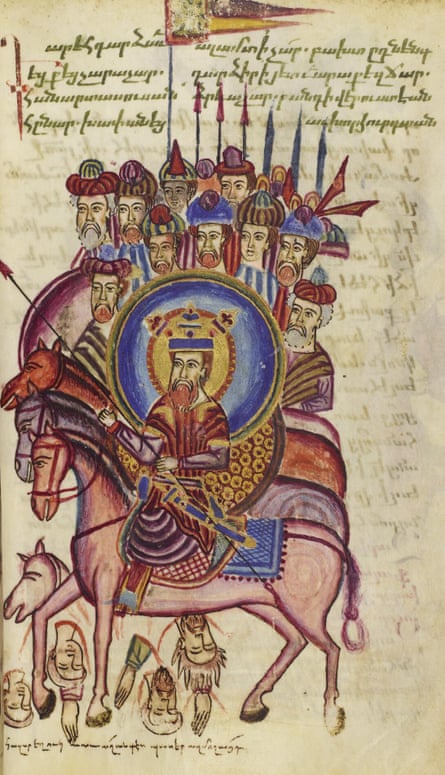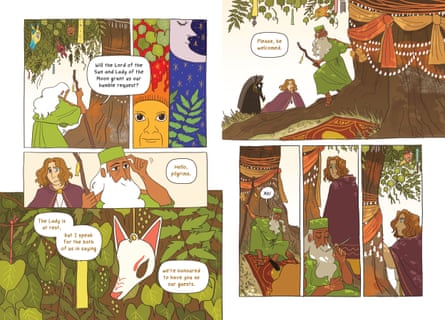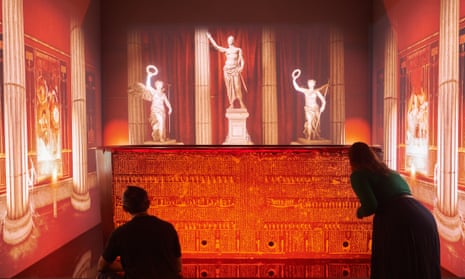The problem with the British Library’s ultimately maddening trawl through medieval and modern images of Alexander the Great is there in the show’s subtitle. The Making of a Myth sounds innocuous until you discover they literally mean it. This exhibition takes such a thoroughly postmodern view of history that it tries to convince you the Macedonian warlord whose conquests linked Europe, Asia and Africa in the fourth-century BC is a figment, his life so wrapped in multiple fictions there is no truth at all to get at.
But Alexander existed. He really was tutored by the philosopher Aristotle before uniting Greece under his rule, defeating the Persian Empire and battling as far as India before dying at just 32. He founded cities called Alexandria from Egypt to Afghanistan. A new style of art, sensual and emotional, spread through the new “Hellenistic” world he created.
Alexander’s continent-spanning legacy can be seen in the range of this show’s sources. There are miniature paintings from Persia, India and Turkey, where the story of Alexander was never forgotten: his conquests and adventures are as prominent in medieval and early modern Islamic culture as in the west. There are gorgeous masterpieces of book art here, such as a tender scene of Alexander comforting his dying enemy Darius painted in Iran in about 1604. In Ethiopia he was believed to be a Christian: an 18th-century Ethiopian scroll depicts Alexander on his famous horse Bucephalus, fighting Satan.

So far, so fascinating. But somehow the curators turn terrific material into irritating dross. One way they do this is by mixing in pop culture with classics of medieval art. Why is a scene from a 2017 Indian TV series being screened next to Mughal manuscripts? It’s like showing the Netflix series Medici in the middle of a display of Renaissance art. And it’s a persistent curatorial tic. Everything from DC comics and covers of potboiler novels to a Disney strip about Scrooge McDuck are shoved in among the manuscripts.
This is not unconsidered populism. It’s something far worse. By mixing up vaguely Alexandrian materials from different times and places, we are being led to think his history is not reliable. Instead, the curators suggest, it’s merely a concoction in which Assassin’s Creed has as much veracity, and is as culturally valid, as the ancient historian Plutarch’s Life of Alexander – shown here in a lovely copy made in Renaissance Florence.
Why do the curators think they have the right to relativise great treasures of world culture and reduce them to the status of comics? Anyway, the idea that history is bunk misses the point about Alexander. His strange allure comes from the way he was absolutely real yet also, to his contemporaries and later generations, superhuman and godlike.
You see that haunting ambiguity in the handful of images here from the ancient world. A coin issued by Alexander or his immediate successors depicts him on Bucephalus attacking enemies who are mounted on an elephant: it commemorates the Battle of Hydaspes in the Punjab in 326BC, when Alexander defeated the Indian ruler Porus before making him an ally. It’s a near “mythic” scene as Alexander’s mighty horse rears before the elephant: yet the battle actually happened. On the other side of the coin, Alexander holds Zeus’s thunderbolt to show he’s descended from the ruler of the gods.
This little object held me because it captures why Alexander has been remembered for more than two millennia, from Armenia to Augsburg. Was he a mass murderer or a philosopher, a visionary or a tyrant – or all of these? I am sure if you asked Oliver Stone, whose Alexander screenplay is here, or the historical novelist Mary Renault, or for that matter Plutarch, they’d all say they found him compelling as a historical figure, who poses huge questions about empire, power and ambition.

This show, however, can’t wait to leave the historical Alexander behind and drown facts in folklore. Medieval legends in east and west reinvented him as a chivalric model for later kings. This paragon was not only kind to his enemies (whereas the real Alexander razed Persepolis) but flew in a device powered by magical beasts.
The exhibition misunderstands medieval romances. In these legendary tales, Arthur, Roland, and Alexander are interchangeable images of heroic kings. A show about romance literature could have been great – but this one gets snagged on the silliest stories about Alexander and fails to put them in that bigger picture.
Speaking of bigger pictures, there are not many of them. There’s a suit of Stuart armour with Alexander on it yet no hint of the great images in tapestries, or Albrecht Altdorfer’s apocalyptic Renaissance painting The Battle of Alexander at Issus, and just an odd little copy of Veronese’s great painting of Alexander.
We end up with a recreation of the tomb of Alexander – not the real one, of course. No, this a materialisation of a virtual space from Assassin’s Creed Origins. If games are as real as histories, why do we need exhibitions like this – or libraries for that matter?
Alexander the Great: The Making of a Myth is at the British Library, London, from 21 October to 19 February.

Comments (…)
Sign in or create your Guardian account to join the discussion